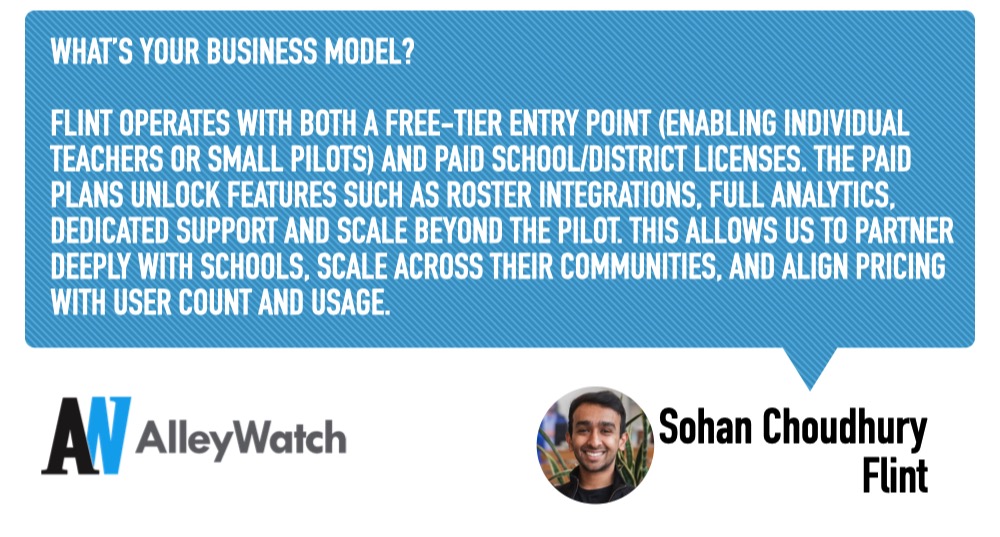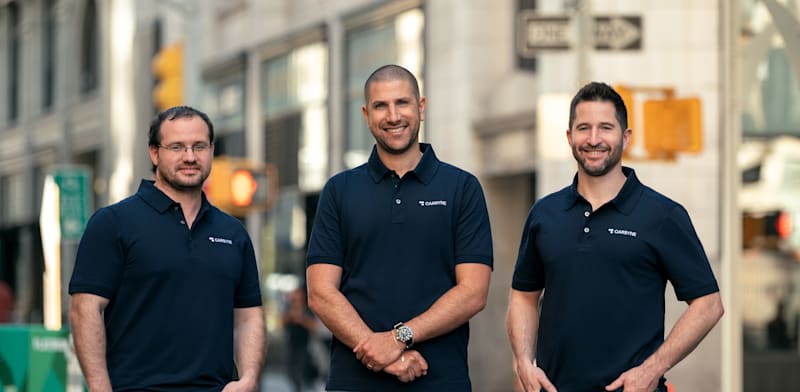Traditional classroom instruction follows a one-size-fits-all model where teachers design lessons for the median student, leaving advanced learners unchallenged and struggling students without adequate support. This structural limitation has long prevented education from delivering on its promise of meeting each student where they are, forcing teachers to choose between personalized attention and covering required material. While AI promised to solve this personalization problem, early implementations often undermined learning by providing direct answers rather than fostering genuine understanding and critical thinking. Flint addresses these challenges by building an AI-native education platform designed from the ground up with educators, not retrofitted from existing tools. Through real-time student analytics, adaptive learning activities, and transparent AI interactions that teachers can monitor live, the platform enables personalized instruction across all subjects while reducing teacher workload rather than adding to it. Already powering 400,000+ users across hundreds of leading independent schools in the US and internationally, Flint recently partnered with Cognita to deploy its platform to 95,000 students across 110 schools, demonstrating scalable adoption that enhances traditional instruction without disrupting classroom dynamics.
AlleyWatch sat down with Flint Cofounder and CEO Sohan Choudhury to learn more about the business, its future plans, recent funding round that brings total funding to $16.7M, and much, much more…
Who were your investors and how much did you raise?
We raised a $15M Series A co-led by Basis Set Ventures and Patron. The round included participation from USC Viterbi, AME Cloud Ventures and notable education leaders including Matt Pittinsky, cofounder of Blackboard, with follow-on investments from Afore Capital and Y Combinator.
Tell us about the product or service that Flint offers.Flint is an AI-powered education platform transforming how students learn and teachers teach. It empowers educators to personalize instruction for every student – not just to the median level – without increasing their workload. Teachers can view live student sessions, track individual strengths and areas for improvement, and design interactive learning experiences. Students can get speaking practice for hundreds of languages, role-play in historical simulations, code alongside an AI collaborator, and create their own learning activities. Flint brings curiosity, agency, and personalization into the classroom.
What inspired the start of Flint?We founded Flint because we saw that while many tools claim to personalize learning, few are built from the ground up in close collaboration with schools and teachers. We knew AI had potential for 1:1 tutoring, but also saw the risk of students being handed answers rather than developing their learning. Our own experiences showed us how broken the current system can feel – where success is the exception, not the rule. Partnering with schools early on, we built a platform that keeps the teacher-student relationship central while using AI to amplify impact.
How is Flint different?Flint is AI-native, not retrofitted. It’s built for schools, with educators, to personalize learning at scale. It doesn’t replace teachers or add complexity – it gives them superpowers. As more schools join, Flint evolves into a living ecosystem where teachers share best practices, students create and collaborate, and the platform gets smarter with every interaction.
What market does Flint target and how big is it?
Flint targets the global K-12 education market. The platform is already used by hundreds of leading independent schools across the United States and internationally, supporting more than 400,000 users and over 150,000 AI-powered learning activities. A recent partnership with Cognita brings Flint to 95,000 students across 110 schools.
What’s your business model?
Flint operates with both a free-tier entry point (enabling individual teachers or small pilots) and paid school/district licenses. The paid plans unlock features such as roster integrations, full analytics, dedicated support and scale beyond the pilot. This allows us to partner deeply with schools, scale across their communities, and align pricing with user count and usage.

How are you preparing for a potential economic slowdown?
We’ve designed Flint to be resilient and accessible. Schools can start using Flint at no cost, with the option to scale through paid licensing as their needs grow. Because we build closely with educators and show measurable impact, schools see Flint as a strategic investment.
What was the funding process like?The funding process reflected the strong momentum we were seeing in schools. Flint was already in use at hundreds of schools, with a growing community of more than 400,000 teachers and students. Our mission and early traction resonated with investors who saw the opportunity to build a new product category for AI-native learning. As part of our Series A, we’re excited to bring on new investors who share our vision for personalizing learning – including two parents of students who use Flint at their schools.
What are the biggest challenges that you faced while raising capital?Some may assume that the biggest challenge of developing an AI edtech product is convincing teachers that AI should be used in the classroom. It is true that AI adoption in education requires the additional responsibility of providing comprehensive professional development, AI literacy resources, and 1:1 support. However, we’ve found that it is actually teachers who ask for us to push out more features, become more innovative, and roll out to more grade levels at their school.
The biggest challenge, arguably, was that the majority of investors have preconceived notions about the potential scalability of an education product. I don’t blame them: historically, very few edtech companies have been venture-scale success stories. They don’t have enough data points to have our level of conviction, which was strengthened only from being on the ground talking to teachers and building rapidly.
We overcame this hurdle by demonstrating our rapid growth (e.g. doubling revenue in the last 6 months) and showing how AI can be used to build adaptive learning software that was previously impossible to build. We’re grateful that our investors–whether it’s our early believers like Y Combinator or Afore Capital or our new investors including Basis Set, Patron, and Matt Pittinsky (cofounder of Blackboard)—see the impact, potential, and global scalability of an edtech product like Flint.
What factors about your business led your investors to write the check?The PC answer? That investors were drawn to our combination of cutting-edge technology, deep mission alignment, and ability to address the long-standing gap in K-12 education by delivering personalized learning at scale without creating additional burden for teachers.
The more realistic reason here is a combination of revenue, product-market fit, and scalability: our growth has been great (e.g. doubling revenue in the last 6 months) and we demonstrated how Flint could be a large business, both by showing how widely our product is being used and how much schools love using Flint.
The more realistic reason here is a combination of revenue, product-market fit, and scalability: our growth has been great (e.g. doubling revenue in the last 6 months) and we demonstrated how Flint could be a large business, both by showing how widely our product is being used and how much schools love using Flint.
What are the milestones you plan to achieve in the next six months?
We plan to expand product development, scale Flint to millions of students globally, and continue growing partnerships with schools and networks that share our vision for personalized learning.
What advice can you offer companies in New York that do not have a fresh injection of capital in the bank?Early on, we learned how important it is to stay close to our users. Some of our best product decisions came from showing up in person, like flying out on red-eyes to meet with schools and listen to teachers directly. That level of closeness has shaped how we build Flint and how we grow.
Where do you see the company going now over the near term?
Flint is entering a period of accelerated growth. We’re focused on scaling adoption in schools globally, continuing to build the best AI-native learning platform, and ensuring every teacher and student has access to personalized, transparent and equitable AI in the classroom.
What’s your favorite fall destination in and around the city?
The Flint Office.


























